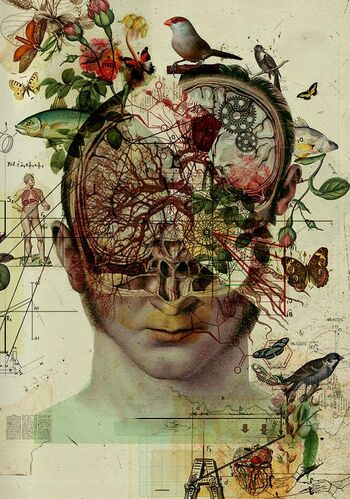Interoception and mental health
May 2021
Our body, mind and emotions are intimately connected. If we are dealing with a mental health challenge, we cannot just address the mind without looking at our physical sensations and our emotions. We are one organism.
Researchers in the field of mental health have become increasingly interested in the concept of Interoception, our ability to feel our body from the inside. Clear links have been found between compromised interoception and mental health (1). Body-centered approaches such as yoga and mindfulness can help us improve our interoception and therefore support the healing process affecting dissociation, traumatic memories, emotional regulation, thought patterns and decision-making.
Researchers in the field of mental health have become increasingly interested in the concept of Interoception, our ability to feel our body from the inside. Clear links have been found between compromised interoception and mental health (1). Body-centered approaches such as yoga and mindfulness can help us improve our interoception and therefore support the healing process affecting dissociation, traumatic memories, emotional regulation, thought patterns and decision-making.
Interoception = Internal + Perception
It is during my Trauma Sensitive Yoga (TCTSY) training that I learned about “interoception”: our ability to feel physical sensations from the inside. Our interoceptive system gives us internal information about our body, for instance whether we are hungry, thirsty, cold, hot, whether our organs are healthy, or whether we breathe fast or slow. It ensures our survival and homeostasis as it gives us information about the state of our body and the actions needed to stay healthy and safe.
The role of interoception
|
Our interoceptive system has 2 main functions:
1. It ensures our survival by signaling to our brain that we have certain basic needs that need to be attended to. For instance, if I am cold, I will put on a jacket which will prevent me from getting hypothermia. If my blood sugar goes down, I might get a sensation of hunger which will encourage me to eat something and prevent potential hypoglycaemia. This function is taken on by the Insular Cortex in the mid-brain. 2. Our interoceptive system forms the basis for our sense of self, our self-identity (2). From a young age, we feel our body from the inside out, even before we have access to language. As infants our sense of self is a sum of physical sensations. It is because of those physical sensations that we start to develop our sense of self, of being embodied. The area of the brain responsible for this function is the Anterior Insular Cortex (AIC). |
Moreover, there is a strong connection between interoception and emotions. We receive information from the inside of our body (as well as from our environment), which travels to the brain stem and some of this information moves up to the brain and generates emotions and awareness about those emotions. Like William James said (1884, p. 194): “I say that for us, emotion dissociated from all bodily feelings is inconceivable.”
Mental Health and Interoception
Mental health and interoception are closely related: Clear links have been found between compromised interoception and mental health, including depression (3), anxiety (4) and addiction (5).
Researchers Rebecca Brewer, Geoff Bird and Jennifer Murphy (6) even suggest that interoceptive ability could be a single factor that would make an individual more susceptible to develop a psychopathology in general.
It is hard to say at this stage whether there is a causal relationship between interoception and mental health. Researcher Rebeccah Brewer says (6): “Poor interoception could lead to psychopathological disorders. However, […] it is likely that you have more of a bidirectional relationship.” If for example, someone has a hard time feeling whether they are full or not, they might be more likely to develop an eating disorder. If someone already has an eating disorder, it is likely that they will try to suppress their feeling of hunger, which might over time impair their general interoceptive abilities.
Researchers Rebecca Brewer, Geoff Bird and Jennifer Murphy (6) even suggest that interoceptive ability could be a single factor that would make an individual more susceptible to develop a psychopathology in general.
It is hard to say at this stage whether there is a causal relationship between interoception and mental health. Researcher Rebeccah Brewer says (6): “Poor interoception could lead to psychopathological disorders. However, […] it is likely that you have more of a bidirectional relationship.” If for example, someone has a hard time feeling whether they are full or not, they might be more likely to develop an eating disorder. If someone already has an eating disorder, it is likely that they will try to suppress their feeling of hunger, which might over time impair their general interoceptive abilities.
Trauma: disconnecting from the body to survive
|
Disconnecting from bodily sensations may be a survival mechanism that allowed the person to survive intense hardship. “Suppression of embodied self-awareness occurs whenever there is a sense of threat that prevents us from finding resources, slowing down, and coregulating with another person.” (7)
For instance, a child who grows up with an alcoholic father will learn to read signs of danger by being attuned to what is happening in the house. When daddy comes home with a smell of whiskey, the child will learn to be hyper-aware of the smell, the sounds, the facial expressions of its parent rather than on its own feeling of discomfort, hunger or fear. |
Recent researches (3, 4, 5) have shown the importance of involving the body in treating mental health issues such as trauma. “When the alarm bell of the emotional brain keeps signaling that you are in danger, no amount of insight will silence it,” says Bessel Van Der Kolk (8). It is not enough to talk about the past, our beliefs, etc. as our body keeps the score. Our nervous system can remain activated and send signals to the whole body that we are unsafe even long after the actual threat has gone.
Depression and Interoception
Interoceptive abilities for a person going through a depression is lessened. Research has shown that unmedicated people with depression have less activity in the insula, which is the center for interoception in the brain. (3)
Individuals going through depression usually do not feel their emotions as intensely and are disconnected from bodily sensations in comparison to healthy individuals.
Individuals going through depression usually do not feel their emotions as intensely and are disconnected from bodily sensations in comparison to healthy individuals.
Anxiety and Interoception
Individuals with anxiety seem to be the outliers with increased interoceptive abilities. Nevertheless, they might be more aware of certain bodily sensations but disconnected from other internal signals, which points to a lessened interoceptive accuracy.
For instance, a person with anxiety might be hyper-aware of their hearth rate which in turn might increase their anxiety (“I’m having a heart attack!”). At the same time, they might be disconnected from the rest of their body which might be perfectly healthy and relaxed.
“Heightened awareness of bodily arousal, alongside misattributions of the source of the arousal, is believed to contribute to the maintenance of panic disorder and social phobia.” (9)
For instance, a person with anxiety might be hyper-aware of their hearth rate which in turn might increase their anxiety (“I’m having a heart attack!”). At the same time, they might be disconnected from the rest of their body which might be perfectly healthy and relaxed.
“Heightened awareness of bodily arousal, alongside misattributions of the source of the arousal, is believed to contribute to the maintenance of panic disorder and social phobia.” (9)
What are the consequences?
Unfortunately, the impairment of our interoceptive abilities comes with issues in the long term: the person may not feel their emotions, they may not feel alive and find it harder to take care of themselves as they are disconnected from their needs. “It is not possible to manage life and maintain homeostatic balance without data on the current state of the organism’s body,” says Damasio (8).
Boost your interoception for your mental health
Interventions that reinforce the interoceptive pathway and accuracy, such as mindfulness and yoga, are likely to have a positive impact on mental health.
“Mindfulness meditation practices have been shown to improve insular functioning and connectivity (10) and to increase interoception (11), and insular function has been linked with increased empathy (12).”
“Mindfulness meditation practices have been shown to improve insular functioning and connectivity (10) and to increase interoception (11), and insular function has been linked with increased empathy (12).”
|
Therapies that improve interoception do not replace the existing therapeutic interventions, including cognitive approaches and medication, but they are complementary. It is important to make sure that people are inside their window of tolerance and learn tools to regulate their autonomic nervous system before they process painful events in the past. “Visiting the past in therapy should be done while people are, biologically speaking, firmly rooted in the present and feeling as calm, safe, and grounded as possible.” (8)
|
In our Trauma Sensitive Yoga classes, we invite participants to re-connect to physical sensations through movements. We do this in a way that respects each persons’ rhythm and readiness to explore their body. We see that students gradually reconnect to their body and are better able to take care of their own needs. This is the starting point to find inner peace and balance again.
Laurence Gilliot is a Trauma Sensitive Yoga (TCTSY) Facilitator and Trauma Release Exercise (TRE) Provider. Through gentle body-centered approaches, she accompanies individuals with mental health challenges to reconnect with their body at their own pace. She offers individualized and non-judgmental support
Reference list
(1) Peter Payne, Peter A. Levine, Mardi A. Crane-Godreau (2015), Somatic experiencing: using interoception and proprioception as core elements of trauma therapy, Frontiers in Psychology, retrieved from https://www.frontiersin.org/articles/10.3389/fpsyg.2015.00093/full?fbclid=IwAR1cdoIxgZe7uBXHSRKpAMuBHccNVayP25mHL80Iidde44ffse9hyL9dTNw
(2) Damasio, A. (2003). Feelings of emotion and the self. Ann. N.Y. Acad. Sci. 1001, 253–261. doi: 10.1196/annals.1279.014
(3) Avery, J. A., Drevets, W. C., Moseman, S. E., Bodurka, J., Barcalow, J. C., and Simmons, W. K. (2013). Major depressive disorder is associated with abnormal interoceptive activity and functional connectivity in the insula. Biol. Psychiatry. 76, 258–266. doi: 10.1016/j.biopsych.2013.11.027
(4) Paulus, MP, Stein, MB, (2010), Interoception in anxiety and depression, Springer Link, doi: 10.1007/s00429-010-0258-9
(5) May, A., Stewart, J., Tapert, S., and Paulus, M. (2014). Current and former methamphetamine-dependent adults show attenuated brain response to pleasant interoceptive stimuli. Drug Alcohol Depend. 140, e138. doi: 10.1016/j.drugalcdep.2014.02.391
(6) The Mindstew Podcast, episode 11, https://www.mindstewpodcast.com/e011/
(7) Fogel, A. (2013), Body sense: The Science and Practice of Embodied Self-Awareness, WW Norton & Co
(8) Van der Kolk, B. (2015), The Body keeps the score: Brain, Mind, and Body in the Healing of Trauma, Penguin Random House
(9) Dunn, B.D., Stefanovitch, I., Evans, D., Oliver, C., Hawkins, A., Dalgleisha, T. (2010) Can you feel the beat? Interoceptive awareness is an interactive function of anxiety- and depression-specific symptom dimensions, NCBI, retrieved from https://www.ncbi.nlm.nih.gov/pmc/articles/PMC2964892/
(10) Holzel, B. K., Carmody, J., Vangel, M., Congleton, C., Yerramsetti, S. M., Gard, T., et al. (2011). Mindfulness practice leads to increases in regional brain gray matter density. Psychiatry Res. 191, 36–43. doi: 10.1016/j.pscychresns.2010.08.006
(11) Farb, N. A. S., Segal, Z. V., and Anderson, A. K. (2013). Mindfulness meditation training alters cortical representations of interoceptive attention. Soc. Cogn. Affect. Neurosci. 8, 15–26. doi: 10.1093/scan/nss066
(12) Singer, T., Critchley, H. D., and Preuschoff, K. (2009). A common role of insula in feelings, empathy and uncertainty. Trends Cogn. Sci. 13, 334–340. doi: 10.1016/j.tics.2009.05.001
(1) Peter Payne, Peter A. Levine, Mardi A. Crane-Godreau (2015), Somatic experiencing: using interoception and proprioception as core elements of trauma therapy, Frontiers in Psychology, retrieved from https://www.frontiersin.org/articles/10.3389/fpsyg.2015.00093/full?fbclid=IwAR1cdoIxgZe7uBXHSRKpAMuBHccNVayP25mHL80Iidde44ffse9hyL9dTNw
(2) Damasio, A. (2003). Feelings of emotion and the self. Ann. N.Y. Acad. Sci. 1001, 253–261. doi: 10.1196/annals.1279.014
(3) Avery, J. A., Drevets, W. C., Moseman, S. E., Bodurka, J., Barcalow, J. C., and Simmons, W. K. (2013). Major depressive disorder is associated with abnormal interoceptive activity and functional connectivity in the insula. Biol. Psychiatry. 76, 258–266. doi: 10.1016/j.biopsych.2013.11.027
(4) Paulus, MP, Stein, MB, (2010), Interoception in anxiety and depression, Springer Link, doi: 10.1007/s00429-010-0258-9
(5) May, A., Stewart, J., Tapert, S., and Paulus, M. (2014). Current and former methamphetamine-dependent adults show attenuated brain response to pleasant interoceptive stimuli. Drug Alcohol Depend. 140, e138. doi: 10.1016/j.drugalcdep.2014.02.391
(6) The Mindstew Podcast, episode 11, https://www.mindstewpodcast.com/e011/
(7) Fogel, A. (2013), Body sense: The Science and Practice of Embodied Self-Awareness, WW Norton & Co
(8) Van der Kolk, B. (2015), The Body keeps the score: Brain, Mind, and Body in the Healing of Trauma, Penguin Random House
(9) Dunn, B.D., Stefanovitch, I., Evans, D., Oliver, C., Hawkins, A., Dalgleisha, T. (2010) Can you feel the beat? Interoceptive awareness is an interactive function of anxiety- and depression-specific symptom dimensions, NCBI, retrieved from https://www.ncbi.nlm.nih.gov/pmc/articles/PMC2964892/
(10) Holzel, B. K., Carmody, J., Vangel, M., Congleton, C., Yerramsetti, S. M., Gard, T., et al. (2011). Mindfulness practice leads to increases in regional brain gray matter density. Psychiatry Res. 191, 36–43. doi: 10.1016/j.pscychresns.2010.08.006
(11) Farb, N. A. S., Segal, Z. V., and Anderson, A. K. (2013). Mindfulness meditation training alters cortical representations of interoceptive attention. Soc. Cogn. Affect. Neurosci. 8, 15–26. doi: 10.1093/scan/nss066
(12) Singer, T., Critchley, H. D., and Preuschoff, K. (2009). A common role of insula in feelings, empathy and uncertainty. Trends Cogn. Sci. 13, 334–340. doi: 10.1016/j.tics.2009.05.001




